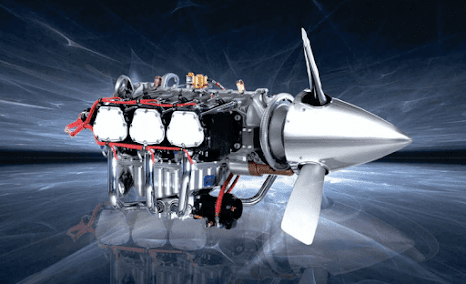Brief Description of Aircraft Piston Engine and Engine Types
A piston engine can be described as a device for the conversion of heat energy from a fuel into the mechanical energy with the help of internal combustion. In a piston engine aircraft, the fuel/air mixture in a piston engine is forced or drawn inside a cylinder, and after compression and ignition, which results into increased temperature and pressure; it acts on a piston and helps in forcing it down inside the cylinder. The aspect when the piston moves from its highest point to its lowest point is referred to as “stroke” which corresponds to one half of a revolution of its crankshaft. One complete cycle is made up of two upward and two downward strokes. The main purpose of each stroke is as follows:
·
Induction
Stroke: When the piston starts
its stroke, an inlet valve in the cylinder head opens up, and when it travels
towards the bottom of its stroke, the combustible mixture of air and fuel is
drawn inside the cylinder. When the piston reaches the end of the stroke, the
valve closes.
·
Compression
Stroke: The combustible gas is
compressed inside the cylinder when the piston travels up to the top of its
stroke leading to the close of both internal and external valves.
·
Power
Stroke: There is an electrical
ignition of the combustible mixture as the piston goes towards its second
downward stroke. This happens by means of a magneto and sparking plug leading
to the expansion of gas.
·
Exhaust
Stroke: At this point of time,
the exhaust valve in the cylinder head now opens and as the piston continues
its second upward stroke. This leads to the expulsion of burnt gases out into
the atmosphere through the exhaust port.
Engine Types of Piston engine aircraft
The design of aircraft engines has revolutionized
gradually. The nature of most of the engines present in recent aircraft is of
the horizontally-opposed configuration.
In-Line Engines
Like many of the automotive engines, the earliest of the
aircraft engines were of the straight or the in-line variety and contained
cylinders in a line. The main advantage of this type of engine is that it is
narrow and this allows the aircraft to have a narrower front fuselage, and that
is why aircraft engine manufacturers prefer it.
V-Type Engines
A V-type engine is the equivalent of two in-line engines
joined in a "V" configuration by a common crankshaft.
Radial Engines
This type of engine consists of one or more rows of
odd-numbered cylinders, which have been arranged in a circle around a central
crankshaft. This engine type had a better power to weight ratio because of the
small size of the crankcase.
Horizontally Opposed Engines
Horizontally opposed engines are often referred to as
boxer or flat engines. They have two banks of cylinders staggered on opposite
sides of a central crankcase. The design is simple, reliable and easy to
maintain, and that is why aircraft
engine manufacturers prefer it.
For more information, you can check the website https://red-aircraft.com/.

Comments
Post a Comment